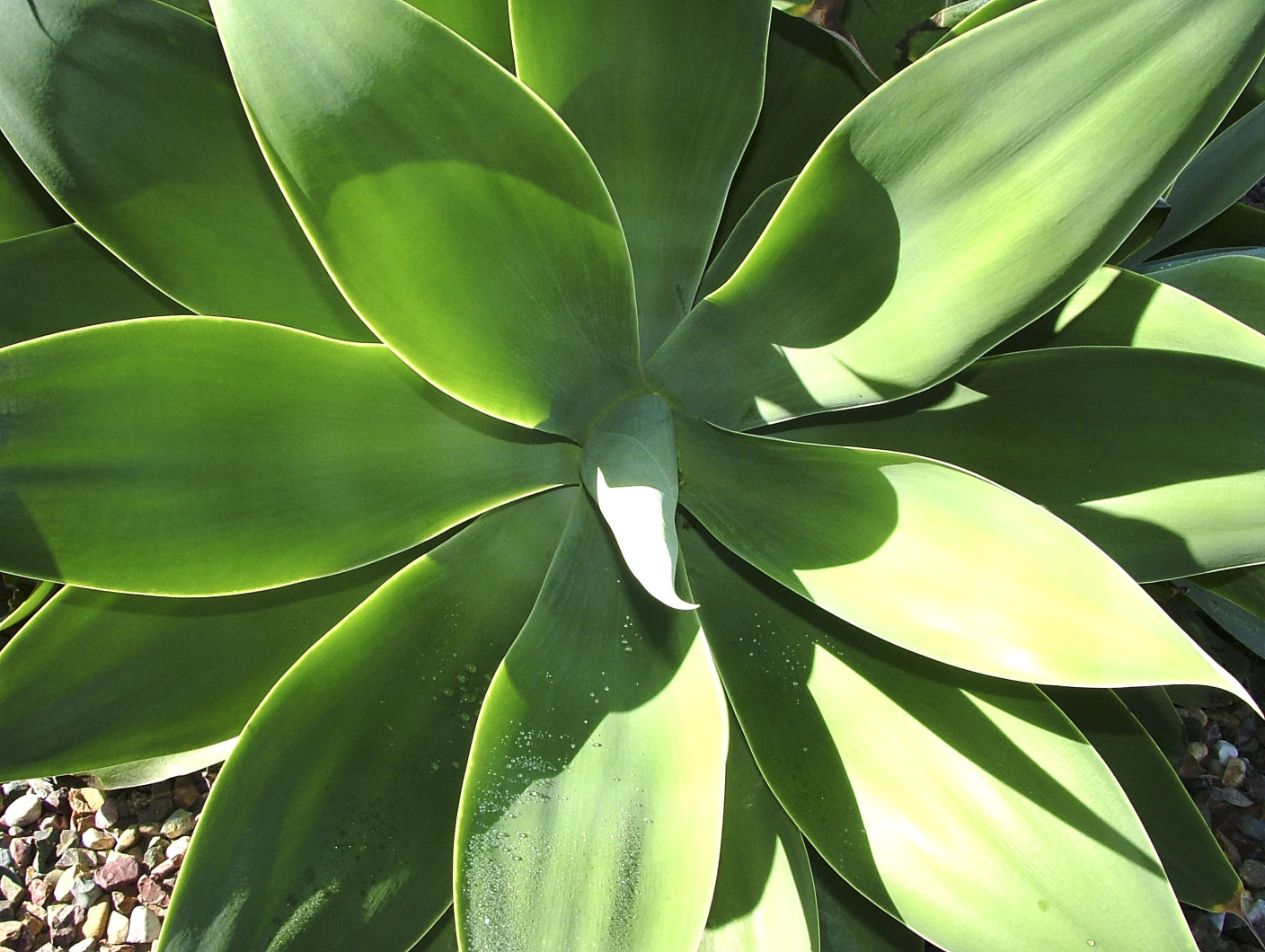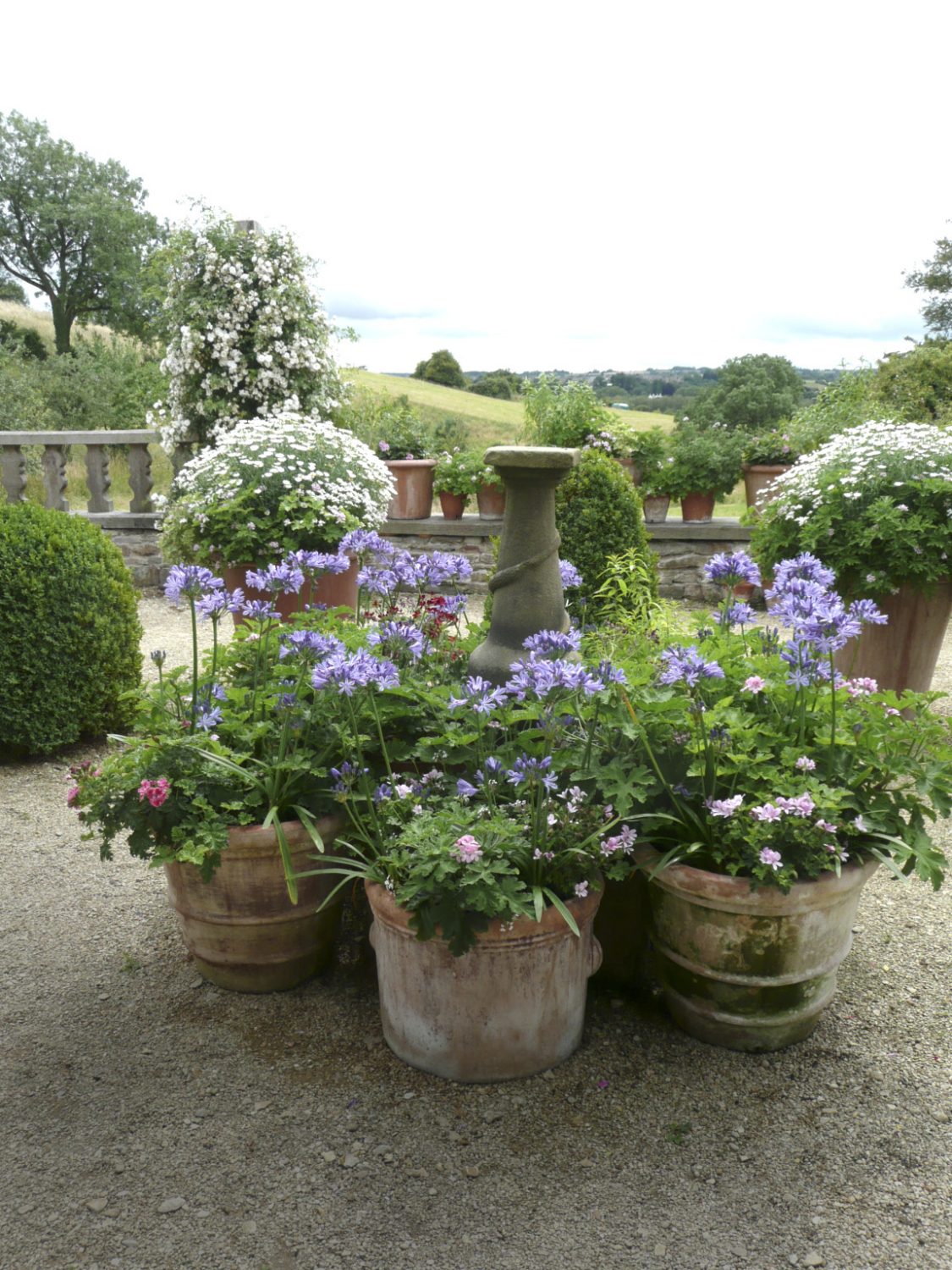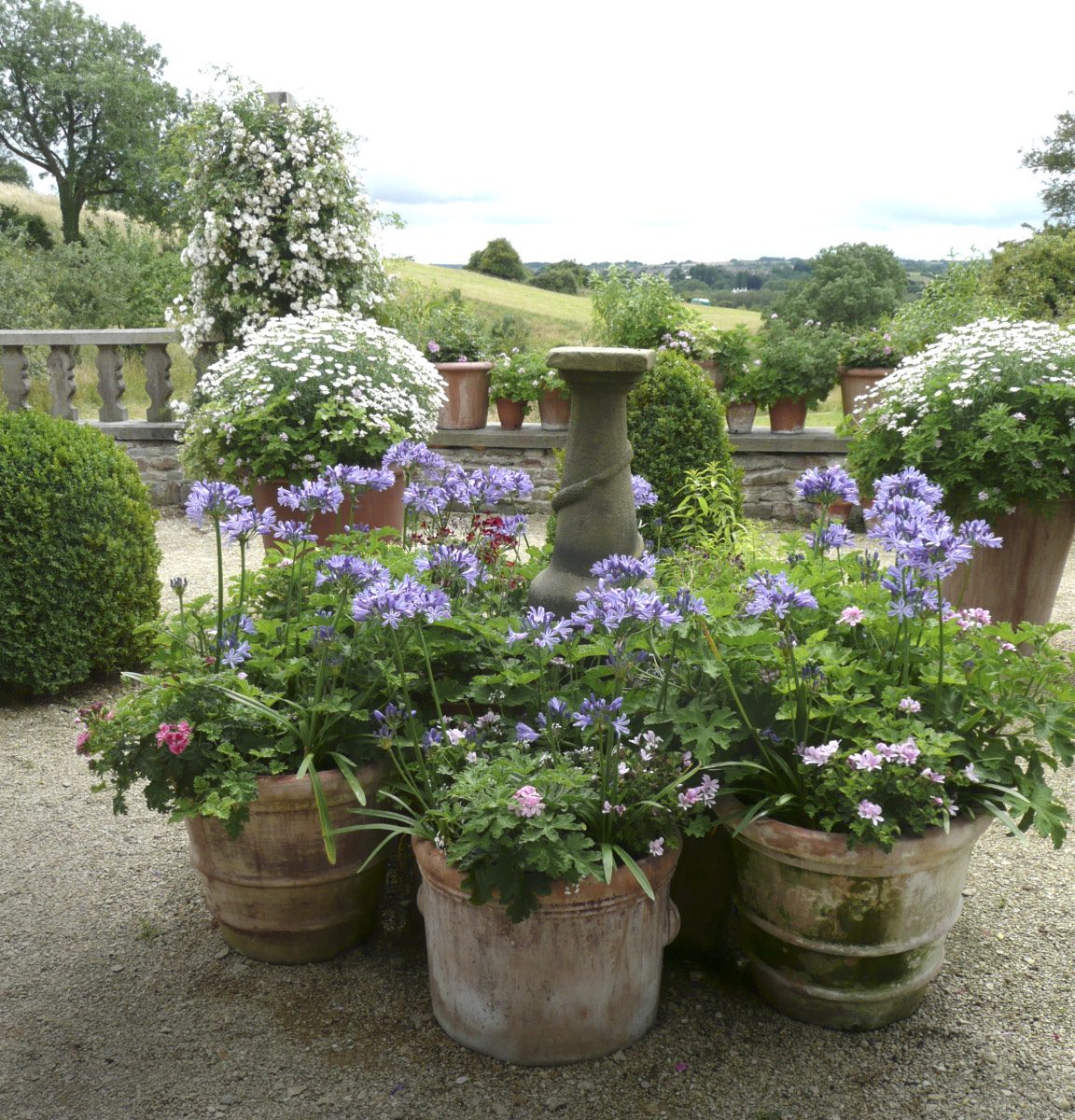I don’t know if any of you have been down to Hanham Court Gardens near Bath. Julian and Isabel Bannerman, Chelsea Gold Medal winners and whose commissions include incredibly imaginative creations at Highgrove, bought the house, part of a glorious mediaeval monastic establishment, in 1983 and created a dream-like garden there. They’ve moved on now but their garden very much remains and is open for the NGS several times in 2016. The reason I mention it is that I remember one of those wonderful days when a group of us drove down to see it. We arrived to find Julian gently watering a huge copper absolutely full of a dense planting of Lavender ‘Hidcote’ and Argyranthemum ‘Cherry Red’. I’ve never forgotten it as the combination of the lavender and the marguerite was completely stunning. ‘Cherry Red’ has daisy-like flowers in a deep carmine-red which fade to different shades of pink as they age. And to cap it all you have feathery grey leaves contrasting with the deep purple of the lavender. I’ve been meaning to try this combination in one of my myriad pots. Maybe this will be the year.
The joy of these sorts of plants is that they don’t need too much watering and of course it is a bit of a relief not to have to spend hours wielding a hosepipe and watering everything in sight. And whilst it is difficult on a wet and windy early April day to imagine hosepipes being anything but redundant after the winter and early spring we have had, I suspect that they will have to be wheeled out by the time summer arrives.
So, are drought resistant plants, or plants that need little watering, right for containers? There are thousands of plants worldwide which are so cleverly adapted to dry conditions. Think of all the silver-leaved plants whose leaves reflect the harsh rays of the sun and whose coating of fine hairs on both stem and leaves help trap moisture around the plant’s tissues. But there are also other adaptations plants have made to cope with lack of moisture so look out for these too when you’re choosing your drought resistant plant which involve minimal care once they are established. Apart from silver leaved plants, there are plants which have succulent leaves and stems, tiny leaves, needle-like leaves and waxy ones too.
Think of how plants grow in their native conditions. I think that agapanthus are one of the most striking plants for pots and they grow in crevices and on cliffs with a minimal amount of soil. We can grow a huge variety of them, both hardy and non-hardy. They’re tough things but do appreciate a good start in life and flower best with a little help from us. So tips for looking after agapanthus would be to protect the less hardy varieties in the winter; keeping them in pots with their roots fairly neatly filling the pot; splitting them in March/April when necessary and growing them in a 2/1 mix of good garden compost and coarse sand or gravel. Feeding them with a high potash feed every three to four weeks in the growing season will encourage a good supply of flowers. Another favourite with strappy leaves is the coastal astelia, Astelia banksii, which is native to New Zealand. Unlike its larger cousin, Astelia chathamica, this one only grows to about three feet and it has the advantage of narrow, sword-like silver leaves perfect as a dramatic single specimen in a pot. There seem to be mixed views about its hardiness and I think that some protection in a hard winter would be good. It has certainly got through this last winter without any problem.
Succulents like Aeonium arboreum ‘Zwartkop’, the Torch Aloe, Aloe arborescens and echeverias are all perfect in pots. However, they are certainly not hardy and would have to be brought under cover in the autumn. They need little or no watering and in the right conditions – ie well drained compost, added grit etc. flourish in a sunny spot. Agaves too are good statement plants but spiky. I like the black spined agave for its blue grey succulent leaves and the large Agave americana. I saw enormous specimens of agave growing in the completely wondrous Jardin Majorelle in Marrakech this year – growing as they should as they have the perfect conditions there, heat and good drainage – but we can have modest sized plants in pots dotted around adding structure to the garden.
Silver leaved plants for pots would include Plectranthus ‘Silver Shield’ which has pretty huge leaves – well, saucer sized – and are felty to the touch. Perfect for a sensory garden actually. Their flowers are a little like those of a salvia and they grow on from cuttings so easily. Or try Convolvulus sabatius which is a cousin to our bindweed but not remotely invasive. This one flowers from summer right through till the autumn and the beginning of the frosts. It’s the prettiest thing with pale blue trailing flowers. Just cut it right back in the spring and it’ll come back to start all over again for the following season. You could combine it in a pot with Convolvulus cneorum which is easily sourced. This treasure has silky silver leaves and its rosy buds open to white flowers.
Every home should have a pot of lemon verbena to brush past in the summer and to snip to make a delicious herbal tea. Aloysia citrodora has strongly scented narrow leaves. This pot would definitely need to be under cover in the winter and the plant cut back either in the winter or early spring. It then comes back from the base. It doesn’t need much attention water wise but is worth feeding or top dressing each year before the season starts. This is such a bee friendly plant – another reason for growing it.
It’s been a bit of a jungle in the greenhouse this winter and we almost needed a machete to create some space. I stuck a few cuttings of Helichrysum petiolare into a bucket of sharp sand a year or so ago and rather forgot about them and the whole thing took off and reached the height of the greenhouse. So another perfect silver leaved plant for dry conditions. I don’t remember watering them at all and what were tiny cuttings have been more than happy growing away for a couple of years. Another plant in there but which has outgrown its space and will have to be cut back dramatically any moment now is Sparmannia africana, or African Hemp.
But if you like foliage plants with giant leaves and fragrant flowers – white with dramatic red and yellow stamens, this is quite a plant to try in a (very) large container. It’s not ideal in a greenhouse really, partly because it doesn’t leave much room for anything else but also because it has too much direct sunlight in there which causes a yellowing of the leaves. Coming from South Africa it is adapted to drought conditions and would be perfect as a large houseplant or specimen plant in a sheltered corner of a courtyard. And its huge leaves are ideally adapted to the plant’s native conditions, being both soft but hairy to the touch. I read that the stamens ‘bristle’ when they’re touched which we’ve never noticed so it’s out to the greenhouse right now to experiment and then, I’m afraid, the whole plant, giant that it is, really is going to be cut back so that we can actually get in there. It’s a good time to take some softwood cuttings so today might be perfect to try a few of those.
TEST
Agaves too are good statement plants but spiky
TEST
- words: Sue Whigham
You may also like
Go with the Flow
Sue Whigham shares some valuable new-to-gardening advice I’m sure that by now we should be used to the rain but I’m not entirely sure that we are. We had a dry, sunny day the other day and how everybody’s mood...
Farm Fables
Jane Howard gets to the bottom of why so many ponds have disappeared across the High Weald I have a new passion, almost an obsession, it’s about ponds. And there’s a distinct possibility I might become a bit of a...
Hedge Issues
Sue Whigham takes a meander along nature’s verdant and vital corridors Recently the BBC’s Today programme carried a feature about England’s hedgerows which created a lot of interest among listeners. On the strength of that, Martha Kearney interviewed one of...















